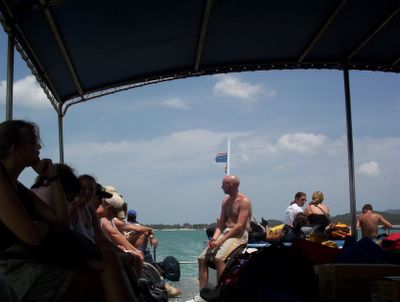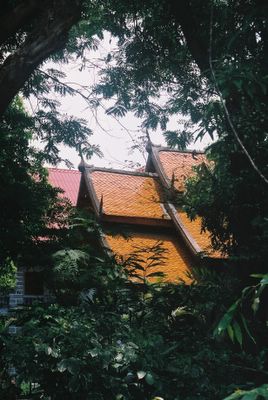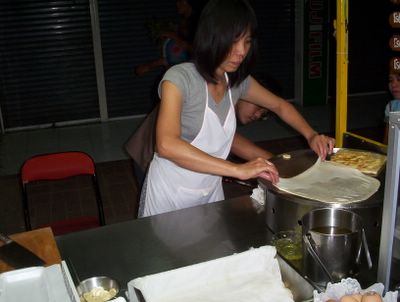Thailand, Part 7: Intestinal Fortitude, See-Thru Airports, and Stinging Water
Wow, bananas! Life’s been crazy lately and for some reason, I just haven’t had the time to sit down and do any writing. But here I am, back in the saddle once more.
The hours following our return from the Bubbin Disco weren’t good. That night the curry, the heat, and everything else caught up to me and I was sick, very sick.
So I didn’t get a lot of sleep that night. Worse, we had to be up early the next morning to catch our flight to Koh Samui, an island in southern Thailand. Somehow, Mike and Rachel managed to get me into the back of a songthaew and I endured the ride to the airport with a minimum of heaving.
For some reason, we got ushered into the executive lounge before the flight. Even more surreal, the entire lounge was filled with backpackers and other grubby-looking western travelers nursing the remains of a hangover from the night before, staring blankly at the TV feeds of the BBC news and sipping cups of weak coffee. We even saw a number of people from the disco the night before (Chiang Mai is a small town, evidently). We loaded onto a small prop-driven plane and off we went.
Once again, the three of us were split up, and I was seated next to a gorgeous brunette yoga instructor from the UK who had just spent a year in India learning massage techniques. We spent most of the flight talking about our travels, our homes, and life and all that kind of good stuff. Sadly, so very very sadly, it turned out she wasn’t heading to the same places we were and couldn’t change her plans no matter how much convincing I pitched. I picked at my meal during breaks in the conversation, and the food was arguably the worst of the whole trip - even the best in the world would have gone down funny, the way I was feeling. The only thing I finished was my cup of coconut icemilk.

Flying into the airport at Koh Samui was one of the coolest experiences I’ve ever had flying. First off, the plane started to descend even before we could see the island – it’s not huge. And then, after landing, coming through the door and seeing the palm trees and smelling the crisp ocean air – I just wanted to inhale it all in, sights, sounds, smells, everything. After the dirty streets of Bangkok, Chiang Rai, and Chaing Mai, it was like arriving in heaven with your name on the guest list.
And the Samui airport was amazing too. If you’ve ever been to the Airport in Honolulu, Hawaii, I’ve been told it’s very similar. We’re talking thatched roofs, open-air terminals, and a paved patio serving as the main concourse. Unlike Canadian and American airports with all their sharp security and stuffiness, this kind of laidback style suited me just fine.

In no time we spotted Mikey, who had flown in from Bangkok that morning. After a brief and happy reunion, Mikey negotiated a shuttle bus ride to the ferry where we’d leave Koh Samui and head over to Koh Pha Ngan (pronounced “ko-pa-nang” for those of you keeping score at home). And you’ve already seen this shot, but hey, one more time for good meaure. This view, at that point in time, was just about the most inviting, exciting thing my puny little brain could imagine. I couldn’t wait to get on the boat. I almost forgot my stomach troubles.

Almost. As we waited to load, I realized I was starting to feel really weak. All I’d really eaten that day was that cup of that coconut stuff and a few bites of some gawd-awful teriyaki-type mess that didn’t look fit for human consumption. And yet I couldn’t bring myself to eat anything. I made a decision then and there to take the meds my doctor sent with me at my first opportunity.
The boat was packed to the gills with dark-tanned surfer bums, girls in bikinis, and the noticeably lighter-skinned and more modestly-dressed backpackers coming from the airport. The 45 minute trip flew by.

Koh Pha Ngan has recently eclipsed Koh Samui as the prime destination for sun-seeking backpackers. The island, 7 km north of Samui, is well known for its white powdery beaches, coconut plantations, coral reefs, and colourful beach-hut accommodations, right on the beach . And between you and me, I’d say that it’s just about as close to paradise as you can find in Thailand. It’s just developed enough to have everything you’d need without making it feel like you’re anywhere close to civilization. We landed at Haat Rin, the party capital of the island – once a month, the seaside town celebrates a full-out full moon beach party. And from what I’ve been told, they’re legendary. Everything you’d expect of a party on the beach with a thousand people in the middle of nowhere and quite a bit more. Unfortunately, we were about two weeks late for it.
Immediately we were attacked by people with three-ring binders full of pictures of beach huts, trying to whisk us away to their rugged resorts on songthaews. We kept walking, since Mikey had a plan. We’d walk the beach, he said, and pick the first place that looked nice that we could get for a reasonable price. Great plan…except that my legs felt like they were made of a tofu-like substance and my stomach felt like it was full of molten lava. But the view was spectacular.

The trip across the beach was a nauseous blur. I did my best to keep up with the crew, but I must have been a pretty pathetic sight. All of that would have been fine if we could have found a place to stay – and there were no vacancies anywhere.
To make an unfortunate story short, I eventually succumbed. We made our way back into town and I crashed out at a restaurant beneath a shady-looking guest house while everyone else continued the search (by the way, if I didn’t say it at the time, thanks guys, I was toast). Ironically, the movie “The Beach” was playing while I was sitting there – a movie which is set in Koh Pha Ngan and Samui. But if any of you have seen it, it doesn’t paint the rosiest of pictures of the area.
The movie ended shortly after Mike, Rachel, and Mikey got back. The news wasn’t good. The only place that had a room that they could find was the very guesthouse that I was sitting at. We took their last room and it wasn’t a good one – the air conditioner was broken and the room had no windows. Pretty miserable. But at least the meds had kicked in and I was finally starting to feel human again.
The rest of my day was pretty uneventful. I stayed close to the guesthouse and had to sacrifice the rest of the day. I did manage to spend a bit of time on the beach with Mike admiring some of the topless sunbathers (there were a lot of them on Pha Ngan’s beaches). But in the end, I played it safe and stayed in the room while everyone else went out and partied on the beach. They returned with stories of drunken teenaged revelries, fire eaters and pyro-shows, limbo sticks, smoking flavoured tobacco on hookahs, and lots and lots of cheap Thai beer.

The good news is that the following morning, I was almost back to normal. I got up early and Mike and I took a quick swim at the beach – the beach was pretty deserted, but the water was as warm as bath water. And a beautiful shade of turquoise.
At the bakery where we had breakfast later that morning, I learned about cheap Thai lighters the hard way – just as I was lighting a smoke, I looked down to see my hand engulfed in flames. I dropped it - and as it sat there, still smoking on the concrete floor of the restaurant, a Thai kid came flying out of nowhere, grabbed the volatile lighter and chucked it sharply at the ground. It made a satisfying little explosion and then the kid went back to watching the WWE wrestling that was playing on the TV. I couldn’t help but think that this sort of thing happens all the time with Thai lighters.
After breakfast, we packed up and decided to move on to another beach. We negotiated a ride with a guy who owned a pickup truck, and before we knew it, we were careening around the island at unsafe speeds down steep one-lane dirt tracks that could only be called roads in the most liberal sense. We traversed the mountainous island in no time, whizzing past coconut plantations and other travelers on rented motorbikes, and made our way onto the prettiest beach of the whole trip – Ao Tong Nai Pan.

We crossed the beach and eventually settled on the Candle Resort. The pic above shows the view from the porch. We took two huts, one for me and Mike and one for Rachel and Mikey. The air conditioning, ocean view, and porches with hammocks were big selling points. The middle one was the one I stayed in.

We didn’t waste any time and packed up a beach bag. We decided to start off on the other side of the beach, across the headland from our resort (we were staying on Yai, and we decided to see what Noi was all about). After a short hike, we passed a crazy luxurious resort with concrete bungalows connected by concrete walkways (sculpted to look like wood). We immediately coined the place the “Flintstone Village.”

Noi was amazing. The white sand was beautiful, the trees provided a bit of shade. And the women were topless and gorgeous. It was exceptional. We spent the rest of the day lounging on the beach, exploring the headlands, and swimming. And the semi-wild dogs paid us a visit too. Mike snapped a shot of one as proof.

We learned quickly about one of the small quirks about Ao Tong Nai Pan – we didn’t know how or why, but there was something in the water that was stinging us every once in a while. We settled on microscopic jellyfish as an explanation, but I haven’t been able to shed any more light on that since we got back. Very strange though.
We made our way back to Yai and spent the remainder of the daylight relaxing before dinner. I had my first taste of giant prawns in a spicy Thai curry. Not to be missed. We had also heard about some rave-like thing called a “Half-Moon Party” happening that night near Haat Rin, but after some investigation and talking to some of the travelers on the beach, we figured out that it was just a sham to try and squeeze some more money out of kids that didn’t know any better (we found out the next day that we were right and it sucked – some people even got stranded there with no way to get back to the resort).
We ended up at a little beachfront bar called the Blue Iguana where the bartended was putting on a show with some flaming devil sticks. Mike and I sparked up a conversation with a couple of German girls while Mikey and Rachel called it an early night and headed back to their hut. Linde and Miriam told us all about the glow-bug-like plankton that lived near the beach, another quirk that only happened there at Ao Tong Nai Pan. And they did, leaving trails of tiny little stars in the wake of your arms and legs as you move through the water. Much Singha, a midnight swim, and fun ensued.

The next day was one of the most relaxing and lazy days that I’ve ever had. Mikey left early, catching the early ferry back to Samui so he could get back to work in Bangkok. The biggest decision that the rest of us had to make all day was whether we wanted to swim, to sunbathe, to read, or crash out for a nap on the hammock. Bliss. I must have gone swimming twenty times that day, often catching flying fish unaware as they basked in the warm bay. And a brief, violent rain shower late in the afternoon added a little character to the day.
Dinner was fresh Tuna steak, which I would recommend to anyone – forget the stuff in the can. And the evening was a repeat of the night before. We went back to the Iguana and found Linde and Miriam waiting for us there.
All-in-all, it was a close-to-perfect two days at Ao Tong Nai Pan. I can’t wait to go back to Koh Pha Ngan. It’s not a question of “if,” only a question of “when.”
Tune-in for the long-awaited conclusion in my next post – Part 8: “Crazy-Eyed Kittens, the Green Lagoon, and the Search for a Bubble Machine.”

































